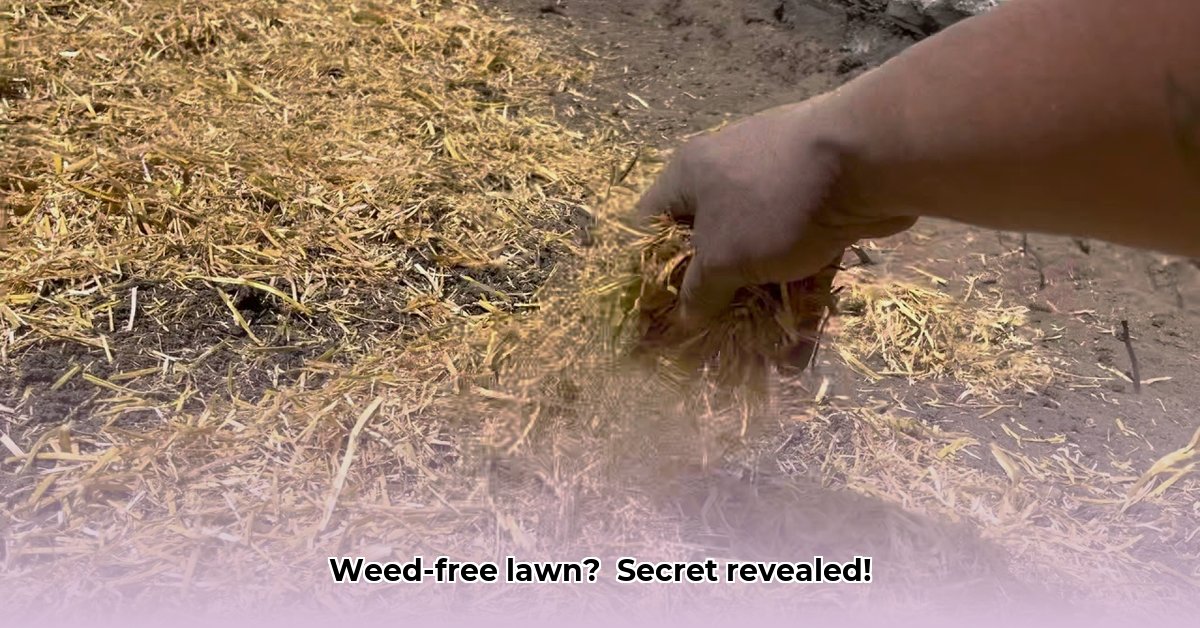
Getting a lush, green lawn shouldn't feel like a constant battle against weeds. EZ Straw from Tractor Supply offers a potentially effective solution, promising weed-free grass seeding with ease. But is it all it's cracked up to be? This comprehensive guide will explore EZ Straw's benefits, drawbacks, and best application practices, helping you decide if it's the right choice for your lawn. We'll also compare it to other mulching methods and highlight areas needing further research. For more on lawn care tools, check out this helpful resource on tractor supply tools.
How EZ Straw Works: A Protective Barrier
EZ Straw isn't just ordinary straw. It's a system designed to improve grass seeding success. The straw itself acts as a physical barrier, blocking sunlight and preventing weed seeds from germinating – effectively shading your seedlings and giving them a competitive edge. The key, however, is the bonding agent that holds the straw together, forming a stable, weed-resistant mat. This prevents the straw from blowing away, ensuring consistent coverage and protection. It's this combined effect – physical barrier and secure anchoring – that makes EZ Straw unique.
Benefits of EZ Straw: A Weed-Free Head Start
Lowe's claims EZ Straw achieves a remarkable 99% weed-free result. This significant reduction in weed competition can save countless hours of weeding and frustration. Beyond weed control, EZ Straw also offers excellent erosion control. The protective straw layer helps prevent valuable topsoil from washing away, ensuring your seeds and young plants remain secure, particularly on slopes or in areas prone to wind. Lastly, it's remarkably easy to apply, saving time and effort compared to dealing with heavy bales of traditional straw or messy wood chips. Isn't saving time and effort a significant advantage for busy homeowners?
Potential Downsides and Environmental Considerations: Areas for Improvement
While EZ Straw shows promise, complete transparency demands acknowledging the unknowns. The exact composition of the bonding agent isn't publicly available, raising questions about its long-term effects on soil health. Could it impact beneficial soil organisms? Does it fully biodegrade? More research is crucial to address these issues conclusively. The following risk assessment matrix highlights potential concerns:
| Risk Factor | Likelihood | Impact | Mitigation Strategy |
|---|---|---|---|
| Bonding agent impact | Moderate | Moderate | Independent studies to assess long-term impacts on soil health and organisms; development of eco-friendly alternatives. |
| Inconsistent application | Moderate | Moderate | Detailed application instructions; videos and online tutorials demonstrating best practices. |
| Supply chain issues | Moderate | Moderate | Exploration of diverse straw sources; collaborations with local farmers and suppliers. |
| Negative customer feedback | Low | Moderate | Active monitoring of customer reviews; quick response to concerns; improved product communication. |
Best Practices for EZ Straw Application: A Step-by-Step Guide
Achieving optimal results requires proper application. Here's a detailed guide:
Prepare the Ground: Create a well-prepared seedbed. Loosen the soil, remove debris, and level the area for optimal seed-to-soil contact.
Distribute the Mulch: Spread EZ Straw evenly, following the packaging's recommended coverage rate. Consistent coverage is key for effective weed suppression.
Gently Press Down: Gently press the EZ Straw into the soil to ensure good contact and minimize the chance of it blowing away.
Seed and Water: Sow seeds according to manufacturer instructions. Water gently to promote germination; avoid overwatering to prevent erosion of the mulch.
Monitor and Maintain: Regularly check for any shifts in the mulch, especially after heavy rain, and readjust as needed.
Comparing EZ Straw to Alternatives: Weighing Your Options
The best mulch depends on your specific needs. Let's compare EZ Straw to other options:
| Feature | EZ Straw | Traditional Straw | Wood Chips |
|---|---|---|---|
| Weed Suppression | Very High (claimed 99%) | Moderate | Moderate |
| Erosion Control | High | Moderate | Moderate |
| Ease of Application | High | Low | Low |
| Cost | Moderate to High | Generally Low | Moderate to High |
| Environmental Impact | Requires further research | Generally low but varies with sourcing | Variable, depending on source & treatment |
Long-Term Impacts and Future Research: The Ongoing Story
While EZ Straw offers immediate benefits, long-term studies are still needed. Independent life-cycle assessments (LCAs) will provide a clearer picture of its environmental impact, specifically addressing the bonding agent's long-term biodegradability and effect on soil ecosystem health. Furthermore, research into optimal application rates for various soil types and climates will allow for fine-tuning best practices. The data is still evolving, and ongoing research will help shape the future of EZ Straw.
Conclusion: Informed Decisions for a Healthier Lawn
EZ Straw mulch offers a potentially effective way to achieve a weed-free lawn, simplifying the process and reducing labor. However, awareness of the uncertainties surrounding the bonding agent's long-term effects on soil health is critical. Careful consideration of its advantages and disadvantages, alongside the data from comparative analyses, is essential for informed decision-making.